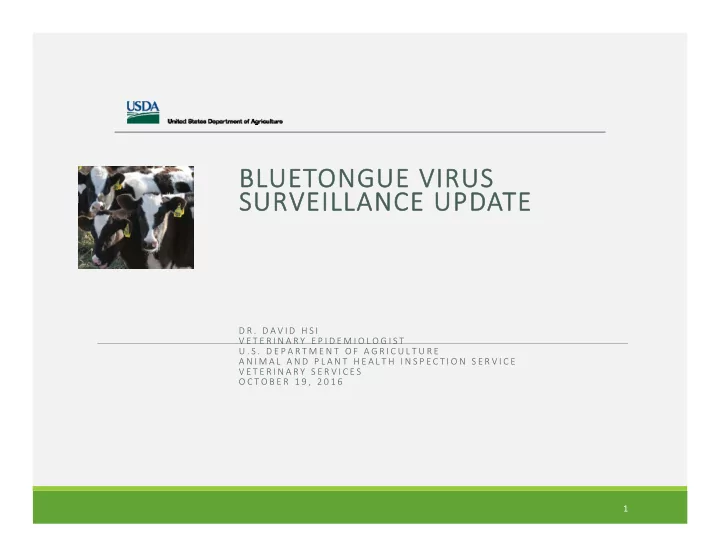

BLUETONGUE VIRUS SURVEILLANCE UPDATE D R . D A V I D H S I V E T E R I N A R Y E P I D E M I O L O G I S T U . S . D E P A R T M E N T O F A G R I C U L T U R E A N I M A L A N D P L A N T H E A L T H I N S P E C T I O N S E R V I C E V E T E R I N A R Y S E R V I C E S O C T O B E R 1 9 , 2 0 1 6 1
Proposed Plan Multi‐faceted BTV surveillance strategy, combining: • Serologic surveillance of cattle slaughter brucellosis samples • Sentinel and vector surveillance, and • Aggregation of testing data from bovine semen collection centers 2
Objectives • Define areas free or with low prevalence of BTV, per OIE guidance, to support trade • Explore BTV prevalence/distribution and assess current ecology given concerns about potential impact of climate change • Begin to establish a BTV serotype distribution map to monitor future changes, and • Help develop national BTV surveillance strategy 3
Serological Surveillance • Update State risk status • Provide baseline information • 600 samples from brucellosis program per low incidence/ free state/region ME, MA, CT, RI, VT, and NH (New England region) o DE/MD (one region) o NY, NJ/PA (one region) o WV, OH, MI, IN, WI, MN, and ND o • Update State designation ‐ A State/ region will be considered low incidence/ free if seroprevalence <2.0% ‐ Epidemiological traceback investigations of positives 4
Sentinel Surveillance • Update State risk status • Real‐time information • ~260 calves sampled per State ‐ Sample subset of low‐incidence/ free states ‐Proposed: OH, PA, NY, WI, MN, MI ‐ Incentives provided • Update State designation ‐ State considered low incidence if seroprevalence <2.0% ‐ PCR testing on positive samples 5
Vector Surveillance • Update disease transmission risk • Subset of sentinel surveillance sites during vector season • Samples analyzed for known and potential vectors 6
AI Center Data Aggregation • Baseline information • Working with Certified Semen Services • Collect testing data from AI centers in low‐incidence/ free States 7
Expected Outcomes • Update BTV seroprevalence, risk information • Support trade • Develop national BTV surveillance strategy • Develop a BTV serotype and vector distribution map in areas surveyed 8
Current Status • Serology testing underway • Outreach to internal and external stakeholders • Assessing funding 9
Questions? 10
Dr. David Hsi Veterinary Epidemiologist U.S. Department of Agriculture Animal and Plant Health Inspection Service Veterinary Services 970‐494‐7298 David.j.hsi@aphis.usda.gov 11
Recommend
More recommend